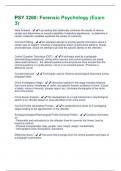PSY 3260: Forensic Psychology (Exam
3)
Meta-Analysis - ✔️✔️A procedure that statistically combines the results of various
studies and determines an overall probability of statistical significance - to determine if
certain moderator variables explained the variety of outcomes.
Criminal Profiling - ✔️✔️An educated attempt to provide specific information about a
certain type of suspect, including a biographical sketch of behavioral patterns, trends,
and tendencies. (Does not attempt to provide the specific identity of the offender)
Control Question Technique (CQT) - ✔️✔️A technique used by a polygraph
administrating professional, during which relevant and control questions are asked
(about past behavior) - the relevant questions should produce more arousal than the
control questions in a guilty person, not so in an innocent person. (Produces a
difference score).
Countermeasures - ✔️✔️Techniques used to influence physiological responses during
polygraph tests.
Crime Investigation Stage - ✔️✔️Information gained in this stage includes evidence
from crime scene, knowledge of victim, and specific forensic evidence of crime. (Cause
of death, nature of wounds, autopsy report, etc.) (Includes photographs of the victim
and crime scene)
Crime Scene Analysis - ✔️✔️The development of a rough behavioral or psychological
sketch of an offender based on clues identified at the crime scene
Criminal Profile Generating Process - ✔️✔️A comprehensive series of 5 overlapping
stages leading to the apprehension of the offender.
Sociopsychological/Psychological Profile (Criminal Profile) - ✔️✔️Contains information
on
- Personality and motivations for the offender (how he commits his crimes, how he
treats his victims)
- Physical characteristics (age, gender, race, height, weight, handedness)
- Demographic Data (Occupation, Education)
Difference Score - ✔️✔️The score that emerges from the control question technique of
a polygraph examination.
, Equivocal Death Analysis - ✔️✔️The application of psychological procedures to
determine whether the mode of death was accident, suicide, homicide, or due to natural
causes.
False Negatives - ✔️✔️Classifying liars as truthful.
False Positives - ✔️✔️Classifying truthful people as liars.
Hypnotically Assisted Memory - ✔️✔️Memories that have been recalled through the
assistance of hypnosis.
Hypnotizability - ✔️✔️The degree to which an individual is responsive to standardized
hypnotic suggestion.
Mass Murder - ✔️✔️Murder involving more than 3 victims in 1 location and within 1
event. (Two categories = Family murder & classic type)
Mode of Death - ✔️✔️(How the death occurred) The instrument or action that led to the
physiological cause of death (e.g., gunshot, knife wound, vehicle accident, etc);
determined during the criminal investigation.
Modus Operandi - ✔️✔️A criminal's characteristic method of operation (MO). This may
change over time to lower the risk of getting caught. (Ex. murder weapon of choice from
knife to a gun, or the method of breaking and entering).
other personalities. Currently known as dissociative identity disorder.
NASH Classification - ✔️✔️Reflects the four traditional modes in which death is
currently reported: natural, accidental, suicidal, or homicidal. (The most frequently made
determination is between suicide and homicide).
Organized Criminals - ✔️✔️This type of murderer is more likely to plan their
murders,target their victims (who are usually strangers), show self-control at the crime
scene by leaving few clues, and possibly act out a violent fantasy against the victim,
including dismemberment or torture. (Likely to plan, use restraints, commit sexual acts
with live victims, emphasize control over the victim by using manipulative or threatening
techniques, and use a car or truck).
Disorganized Criminals - ✔️✔️This type of murderer is less apt to plan their crime in
detail, obtains victims by chance, and behaves haphazardly during the crime. (Likely to
leave a weapon at the crime scene, re-position the dead body, preform sexual acts with
a dead body, keep the dead body, try to depersonalize the body, not use a vehicle).




